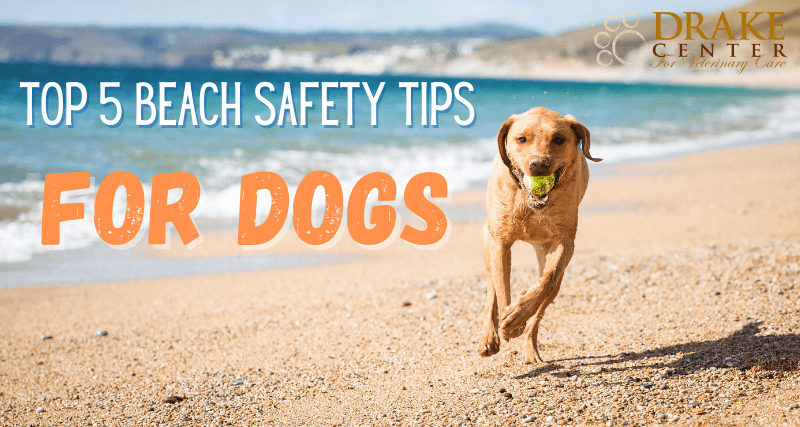By Nicole Abrego
The First Day of Summer is fast approaching which means pool parties and beach trips are coming! Living in Encinitas in beautiful Southern California, there’s no shortage of picture-perfect beaches to take your dog. Before you hit the surf, here are 5 tips to keep your furry friend safe during your beach day trip.
Follow the Rules:
As much as we love taking our pups everywhere, you need to ensure that you follow any posted rules regarding pets in public places. Unfortunately, not all beaches allow dogs and pet-friendly beaches usually require dogs being on a leash, be current on all vaccinations, and you have to clean up after your pet. Failure to abide by these rules can result in receiving a citation or fine, which would not be the best way to spend your beach day. By doing your due diligence in researching the rules and regulations for pets visiting local beaches, you can avoid the possibility of having your beach trip go awry with a hefty fine or being told your pet can’t be there.
Not All Dogs Can Doggie Paddle
Contrary to popular belief, not all dogs are natural swimmers (well, except maybe labradors!). When taking your pup to the beach, especially for the first time, it’s safer to assume that they won’t be an automatic swimmer and you’ll need to keep a close eye on them while around the ocean shore. Waves can easily rush up and having your dog swept into the ocean can be a terrifying ordeal, even more so if they are not great swimmers.
Always remember to keep your dog close by and supervised at all times while at the beach and near the water. Investing in a doggie life jacket is another option to consider for an extra layer of water protection. There are also ways to teach your dog how to swim with some simple steps! The key is to take things nice and slow with your pet. Don’t force them into the water if they are not comfortable and keep a close eye on them while they frolic about in the ocean.
Watch What They Drink
While on the topic of water, some dogs may be tempted to drink the salt water from the ocean when they get thirsty. However, drinking salt water is incredibly harmful and can result in symptoms of salt water poisoning such as vomiting, diarrhea, and weakness.
Pack plenty of fresh cold water for your dog to drink and encourage them to drink water frequently while they play out in the hot weather. A collapsible water dish would be a perfect investment and is easy to keep packed in the car for easy access.
Mind Your Step!
Between the hot sand, scorching pavement, and possible sharp hazards buried in the sand, it’s key to keep your dog’s sensitive paw pads in mind while at the beach. The sand and pavement can scorch your dog’s paw pads during hot days, which could lead to blisters or even severe burns. Sharp items such as rocks, shells, or debris can possibly puncture and injure your pup’s paws. Be mindful of where your pet steps while at the beach. You might consider having your dog wear doggie booties for extra protection while they are out adventuring. Additionally, having a first aid kit on hand will help ease any worries as you would be able to treat any minor injuries that may occur during your beach trip. If your pet experiences a severe injury, be sure to contact your veterinarian immediately for urgent care.
Avoid Overheating
Protecting your pet from heat exhaustion and heat stroke is imperative for their safety during the summer months. Dogs can easily over-exert themselves while playing in the sand and hot sun, leaving them more vulnerable to heat-related illness. Brachycephalic dog breeds with short muzzles, such as pugs, boxers, and bulldogs, are at higher risk of heat stroke and should take extra caution during hot weather. Other predisposing risks include obesity, underlying heart disease and upper airway disorders.
Ways to protect your pet is to avoid the beach during the hottest parts of the day, usually between 10am - 4pm. Keep playtime to a minimum, encourage your pet to take breaks and have them drink lots of fresh cold water. Provide plenty of shade and take it easy when you notice them panting heavily. If your pet seems overly tired, it may be best to wrap up the beach trip and get them to a shaded place with air conditioning.
Know the Signs of Heat Stroke:
- Rapid, intense panting
- Weakness
- Ataxia (staggering gait)
- Collapse
- Pale and/or dry gums
- A rectal temperature of 105 degrees or higher
Immediate treatment of heat stroke is critical. Spray your pet down or place him/her in a tub of cool water and seek veterinary care immediately. Monitoring your pet’s temperature throughout the treatment process is very important, as it is possible to cool the pet down too much, resulting in hypothermia and further complications. Complications of heat stroke can include kidney failure, problems with blood coagulation, septic shock and heart arrhythmias or death.
If a beach trip is in your pet’s future, we hope these tips will help you and your pet have the best (and safest) beach experience possible. If you need to schedule your pet’s appointment or have any questions, please contact us here.
The Drake Center for Veterinary Care is an AAHA-accredited animal hospital located in Encinitas, CA. The Drake Center loves being a source of information for all pet owners across the country however if you have any questions regarding pet care and do not live in Encinitas, CA or surrounding cities, we encourage you to contact your local veterinarian.

